Intercultural Communication & Negotiation Skills: A Reflective Journal
VerifiedAdded on 2023/06/11
|7
|2219
|205
AI Summary
This reflective journal delves into the student's understanding of intercultural communication and negotiation skills, highlighting their importance for future career goals. It examines various models of intercultural communication, such as the Hofstede, House, and Hall models, and their application in understanding diverse communication patterns. The journal reflects on the impact of both macro and micro-cultural factors on intercultural interactions and emphasizes the significance of non-verbal communication. It also discusses the role of negotiation in resolving conflicts and misunderstandings, particularly in organizational settings. The student acknowledges the limitations of negotiation as a sole solution and stresses the importance of understanding different perspectives. Overall, the journal demonstrates a comprehensive understanding of intercultural communication and negotiation, with insights on how to improve these skills for professional success. Desklib provides access to this and many other solved assignments.

Reflective journal
0 | P a g e
0 | P a g e
Paraphrase This Document
Need a fresh take? Get an instant paraphrase of this document with our AI Paraphraser
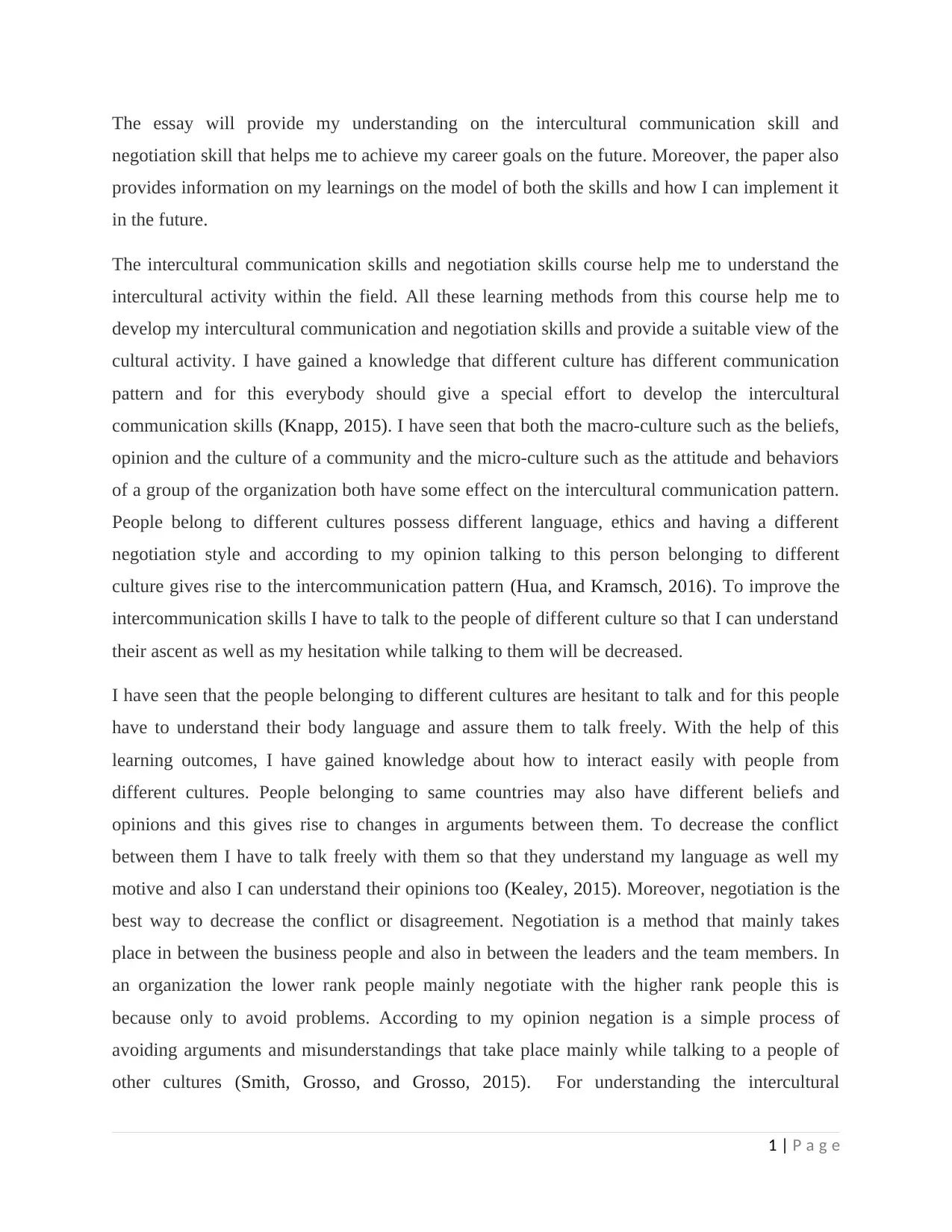
The essay will provide my understanding on the intercultural communication skill and
negotiation skill that helps me to achieve my career goals on the future. Moreover, the paper also
provides information on my learnings on the model of both the skills and how I can implement it
in the future.
The intercultural communication skills and negotiation skills course help me to understand the
intercultural activity within the field. All these learning methods from this course help me to
develop my intercultural communication and negotiation skills and provide a suitable view of the
cultural activity. I have gained a knowledge that different culture has different communication
pattern and for this everybody should give a special effort to develop the intercultural
communication skills (Knapp, 2015). I have seen that both the macro-culture such as the beliefs,
opinion and the culture of a community and the micro-culture such as the attitude and behaviors
of a group of the organization both have some effect on the intercultural communication pattern.
People belong to different cultures possess different language, ethics and having a different
negotiation style and according to my opinion talking to this person belonging to different
culture gives rise to the intercommunication pattern (Hua, and Kramsch, 2016). To improve the
intercommunication skills I have to talk to the people of different culture so that I can understand
their ascent as well as my hesitation while talking to them will be decreased.
I have seen that the people belonging to different cultures are hesitant to talk and for this people
have to understand their body language and assure them to talk freely. With the help of this
learning outcomes, I have gained knowledge about how to interact easily with people from
different cultures. People belonging to same countries may also have different beliefs and
opinions and this gives rise to changes in arguments between them. To decrease the conflict
between them I have to talk freely with them so that they understand my language as well my
motive and also I can understand their opinions too (Kealey, 2015). Moreover, negotiation is the
best way to decrease the conflict or disagreement. Negotiation is a method that mainly takes
place in between the business people and also in between the leaders and the team members. In
an organization the lower rank people mainly negotiate with the higher rank people this is
because only to avoid problems. According to my opinion negation is a simple process of
avoiding arguments and misunderstandings that take place mainly while talking to a people of
other cultures (Smith, Grosso, and Grosso, 2015). For understanding the intercultural
1 | P a g e
negotiation skill that helps me to achieve my career goals on the future. Moreover, the paper also
provides information on my learnings on the model of both the skills and how I can implement it
in the future.
The intercultural communication skills and negotiation skills course help me to understand the
intercultural activity within the field. All these learning methods from this course help me to
develop my intercultural communication and negotiation skills and provide a suitable view of the
cultural activity. I have gained a knowledge that different culture has different communication
pattern and for this everybody should give a special effort to develop the intercultural
communication skills (Knapp, 2015). I have seen that both the macro-culture such as the beliefs,
opinion and the culture of a community and the micro-culture such as the attitude and behaviors
of a group of the organization both have some effect on the intercultural communication pattern.
People belong to different cultures possess different language, ethics and having a different
negotiation style and according to my opinion talking to this person belonging to different
culture gives rise to the intercommunication pattern (Hua, and Kramsch, 2016). To improve the
intercommunication skills I have to talk to the people of different culture so that I can understand
their ascent as well as my hesitation while talking to them will be decreased.
I have seen that the people belonging to different cultures are hesitant to talk and for this people
have to understand their body language and assure them to talk freely. With the help of this
learning outcomes, I have gained knowledge about how to interact easily with people from
different cultures. People belonging to same countries may also have different beliefs and
opinions and this gives rise to changes in arguments between them. To decrease the conflict
between them I have to talk freely with them so that they understand my language as well my
motive and also I can understand their opinions too (Kealey, 2015). Moreover, negotiation is the
best way to decrease the conflict or disagreement. Negotiation is a method that mainly takes
place in between the business people and also in between the leaders and the team members. In
an organization the lower rank people mainly negotiate with the higher rank people this is
because only to avoid problems. According to my opinion negation is a simple process of
avoiding arguments and misunderstandings that take place mainly while talking to a people of
other cultures (Smith, Grosso, and Grosso, 2015). For understanding the intercultural
1 | P a g e
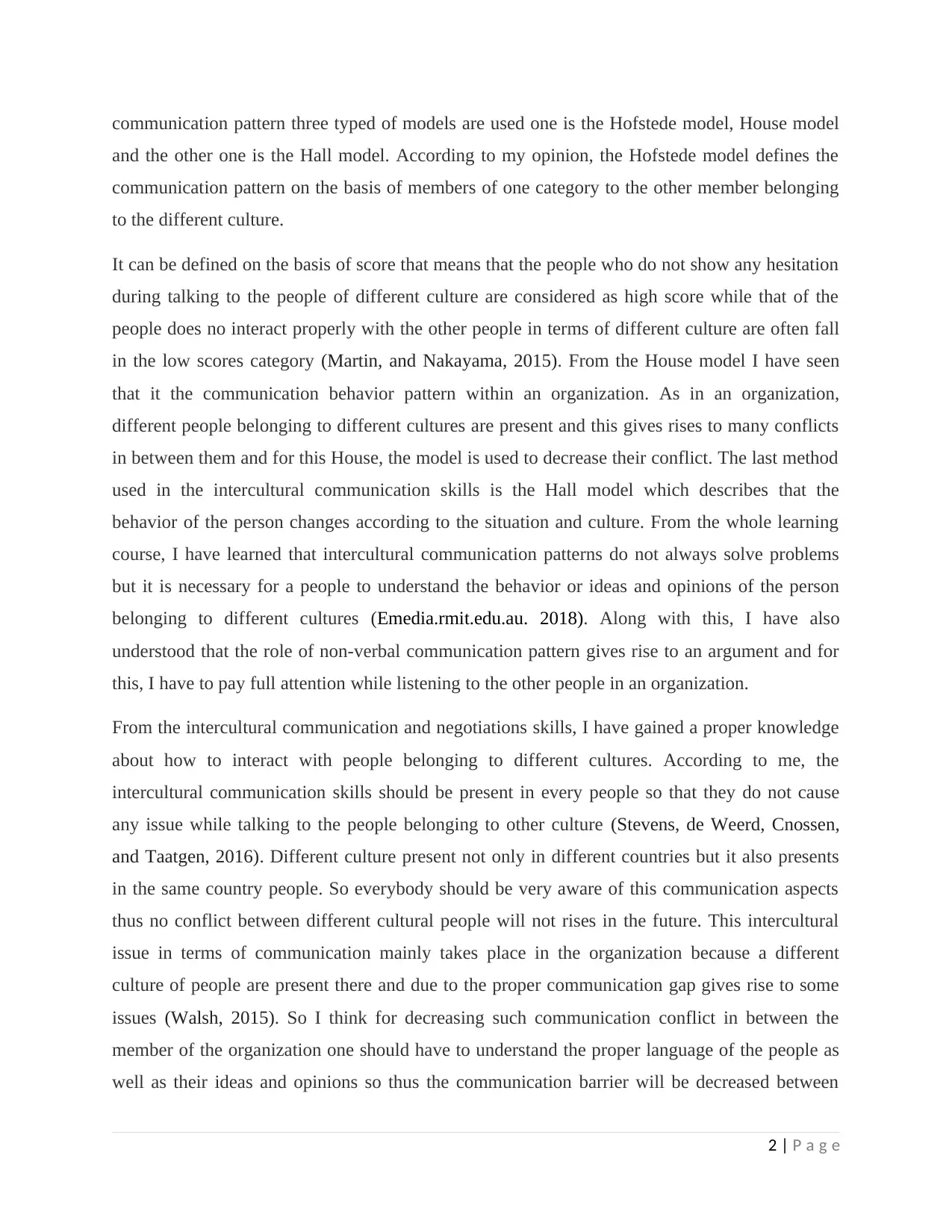
communication pattern three typed of models are used one is the Hofstede model, House model
and the other one is the Hall model. According to my opinion, the Hofstede model defines the
communication pattern on the basis of members of one category to the other member belonging
to the different culture.
It can be defined on the basis of score that means that the people who do not show any hesitation
during talking to the people of different culture are considered as high score while that of the
people does no interact properly with the other people in terms of different culture are often fall
in the low scores category (Martin, and Nakayama, 2015). From the House model I have seen
that it the communication behavior pattern within an organization. As in an organization,
different people belonging to different cultures are present and this gives rises to many conflicts
in between them and for this House, the model is used to decrease their conflict. The last method
used in the intercultural communication skills is the Hall model which describes that the
behavior of the person changes according to the situation and culture. From the whole learning
course, I have learned that intercultural communication patterns do not always solve problems
but it is necessary for a people to understand the behavior or ideas and opinions of the person
belonging to different cultures (Emedia.rmit.edu.au. 2018). Along with this, I have also
understood that the role of non-verbal communication pattern gives rise to an argument and for
this, I have to pay full attention while listening to the other people in an organization.
From the intercultural communication and negotiations skills, I have gained a proper knowledge
about how to interact with people belonging to different cultures. According to me, the
intercultural communication skills should be present in every people so that they do not cause
any issue while talking to the people belonging to other culture (Stevens, de Weerd, Cnossen,
and Taatgen, 2016). Different culture present not only in different countries but it also presents
in the same country people. So everybody should be very aware of this communication aspects
thus no conflict between different cultural people will not rises in the future. This intercultural
issue in terms of communication mainly takes place in the organization because a different
culture of people are present there and due to the proper communication gap gives rise to some
issues (Walsh, 2015). So I think for decreasing such communication conflict in between the
member of the organization one should have to understand the proper language of the people as
well as their ideas and opinions so thus the communication barrier will be decreased between
2 | P a g e
and the other one is the Hall model. According to my opinion, the Hofstede model defines the
communication pattern on the basis of members of one category to the other member belonging
to the different culture.
It can be defined on the basis of score that means that the people who do not show any hesitation
during talking to the people of different culture are considered as high score while that of the
people does no interact properly with the other people in terms of different culture are often fall
in the low scores category (Martin, and Nakayama, 2015). From the House model I have seen
that it the communication behavior pattern within an organization. As in an organization,
different people belonging to different cultures are present and this gives rises to many conflicts
in between them and for this House, the model is used to decrease their conflict. The last method
used in the intercultural communication skills is the Hall model which describes that the
behavior of the person changes according to the situation and culture. From the whole learning
course, I have learned that intercultural communication patterns do not always solve problems
but it is necessary for a people to understand the behavior or ideas and opinions of the person
belonging to different cultures (Emedia.rmit.edu.au. 2018). Along with this, I have also
understood that the role of non-verbal communication pattern gives rise to an argument and for
this, I have to pay full attention while listening to the other people in an organization.
From the intercultural communication and negotiations skills, I have gained a proper knowledge
about how to interact with people belonging to different cultures. According to me, the
intercultural communication skills should be present in every people so that they do not cause
any issue while talking to the people belonging to other culture (Stevens, de Weerd, Cnossen,
and Taatgen, 2016). Different culture present not only in different countries but it also presents
in the same country people. So everybody should be very aware of this communication aspects
thus no conflict between different cultural people will not rises in the future. This intercultural
issue in terms of communication mainly takes place in the organization because a different
culture of people are present there and due to the proper communication gap gives rise to some
issues (Walsh, 2015). So I think for decreasing such communication conflict in between the
member of the organization one should have to understand the proper language of the people as
well as their ideas and opinions so thus the communication barrier will be decreased between
2 | P a g e
⊘ This is a preview!⊘
Do you want full access?
Subscribe today to unlock all pages.

Trusted by 1+ million students worldwide
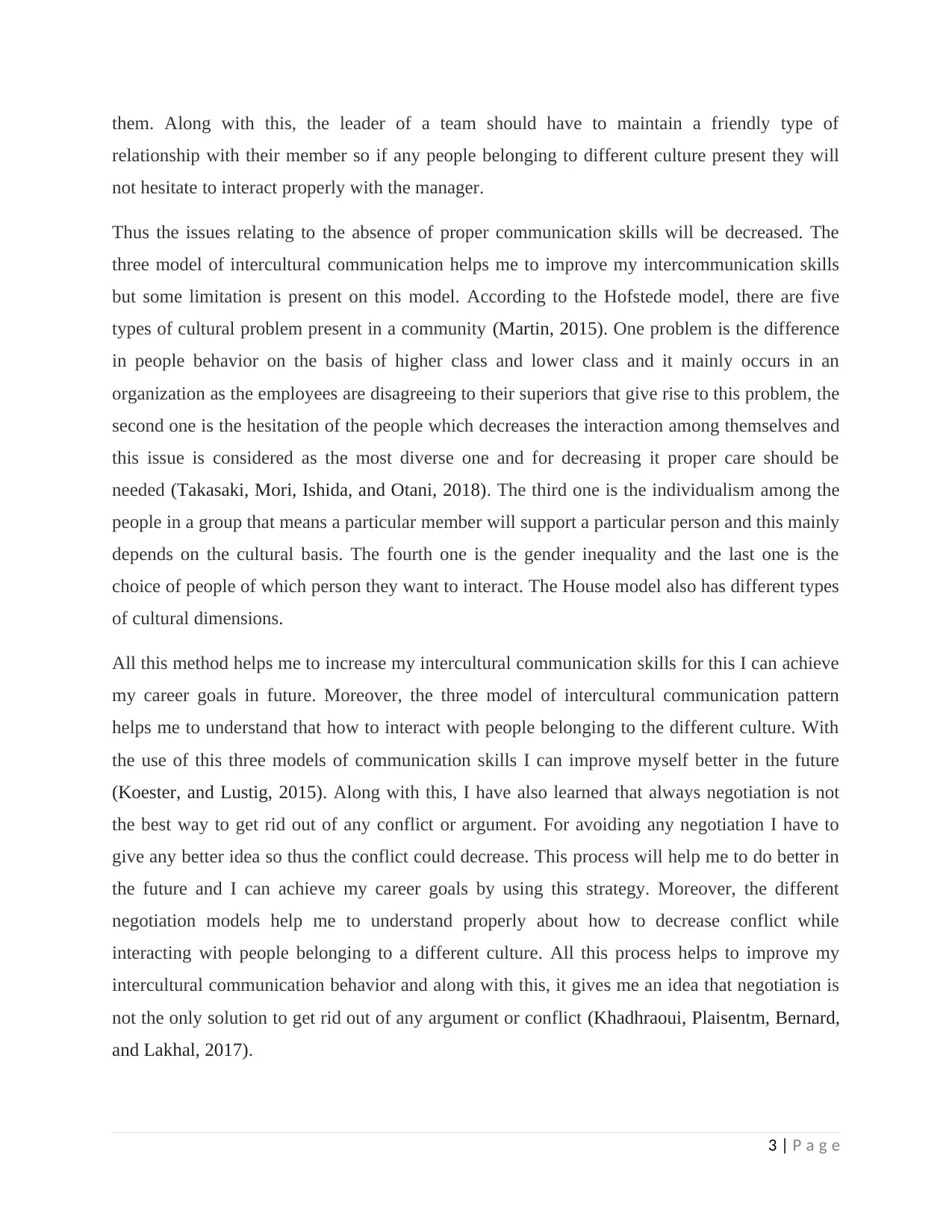
them. Along with this, the leader of a team should have to maintain a friendly type of
relationship with their member so if any people belonging to different culture present they will
not hesitate to interact properly with the manager.
Thus the issues relating to the absence of proper communication skills will be decreased. The
three model of intercultural communication helps me to improve my intercommunication skills
but some limitation is present on this model. According to the Hofstede model, there are five
types of cultural problem present in a community (Martin, 2015). One problem is the difference
in people behavior on the basis of higher class and lower class and it mainly occurs in an
organization as the employees are disagreeing to their superiors that give rise to this problem, the
second one is the hesitation of the people which decreases the interaction among themselves and
this issue is considered as the most diverse one and for decreasing it proper care should be
needed (Takasaki, Mori, Ishida, and Otani, 2018). The third one is the individualism among the
people in a group that means a particular member will support a particular person and this mainly
depends on the cultural basis. The fourth one is the gender inequality and the last one is the
choice of people of which person they want to interact. The House model also has different types
of cultural dimensions.
All this method helps me to increase my intercultural communication skills for this I can achieve
my career goals in future. Moreover, the three model of intercultural communication pattern
helps me to understand that how to interact with people belonging to the different culture. With
the use of this three models of communication skills I can improve myself better in the future
(Koester, and Lustig, 2015). Along with this, I have also learned that always negotiation is not
the best way to get rid out of any conflict or argument. For avoiding any negotiation I have to
give any better idea so thus the conflict could decrease. This process will help me to do better in
the future and I can achieve my career goals by using this strategy. Moreover, the different
negotiation models help me to understand properly about how to decrease conflict while
interacting with people belonging to a different culture. All this process helps to improve my
intercultural communication behavior and along with this, it gives me an idea that negotiation is
not the only solution to get rid out of any argument or conflict (Khadhraoui, Plaisentm, Bernard,
and Lakhal, 2017).
3 | P a g e
relationship with their member so if any people belonging to different culture present they will
not hesitate to interact properly with the manager.
Thus the issues relating to the absence of proper communication skills will be decreased. The
three model of intercultural communication helps me to improve my intercommunication skills
but some limitation is present on this model. According to the Hofstede model, there are five
types of cultural problem present in a community (Martin, 2015). One problem is the difference
in people behavior on the basis of higher class and lower class and it mainly occurs in an
organization as the employees are disagreeing to their superiors that give rise to this problem, the
second one is the hesitation of the people which decreases the interaction among themselves and
this issue is considered as the most diverse one and for decreasing it proper care should be
needed (Takasaki, Mori, Ishida, and Otani, 2018). The third one is the individualism among the
people in a group that means a particular member will support a particular person and this mainly
depends on the cultural basis. The fourth one is the gender inequality and the last one is the
choice of people of which person they want to interact. The House model also has different types
of cultural dimensions.
All this method helps me to increase my intercultural communication skills for this I can achieve
my career goals in future. Moreover, the three model of intercultural communication pattern
helps me to understand that how to interact with people belonging to the different culture. With
the use of this three models of communication skills I can improve myself better in the future
(Koester, and Lustig, 2015). Along with this, I have also learned that always negotiation is not
the best way to get rid out of any conflict or argument. For avoiding any negotiation I have to
give any better idea so thus the conflict could decrease. This process will help me to do better in
the future and I can achieve my career goals by using this strategy. Moreover, the different
negotiation models help me to understand properly about how to decrease conflict while
interacting with people belonging to a different culture. All this process helps to improve my
intercultural communication behavior and along with this, it gives me an idea that negotiation is
not the only solution to get rid out of any argument or conflict (Khadhraoui, Plaisentm, Bernard,
and Lakhal, 2017).
3 | P a g e
Paraphrase This Document
Need a fresh take? Get an instant paraphrase of this document with our AI Paraphraser
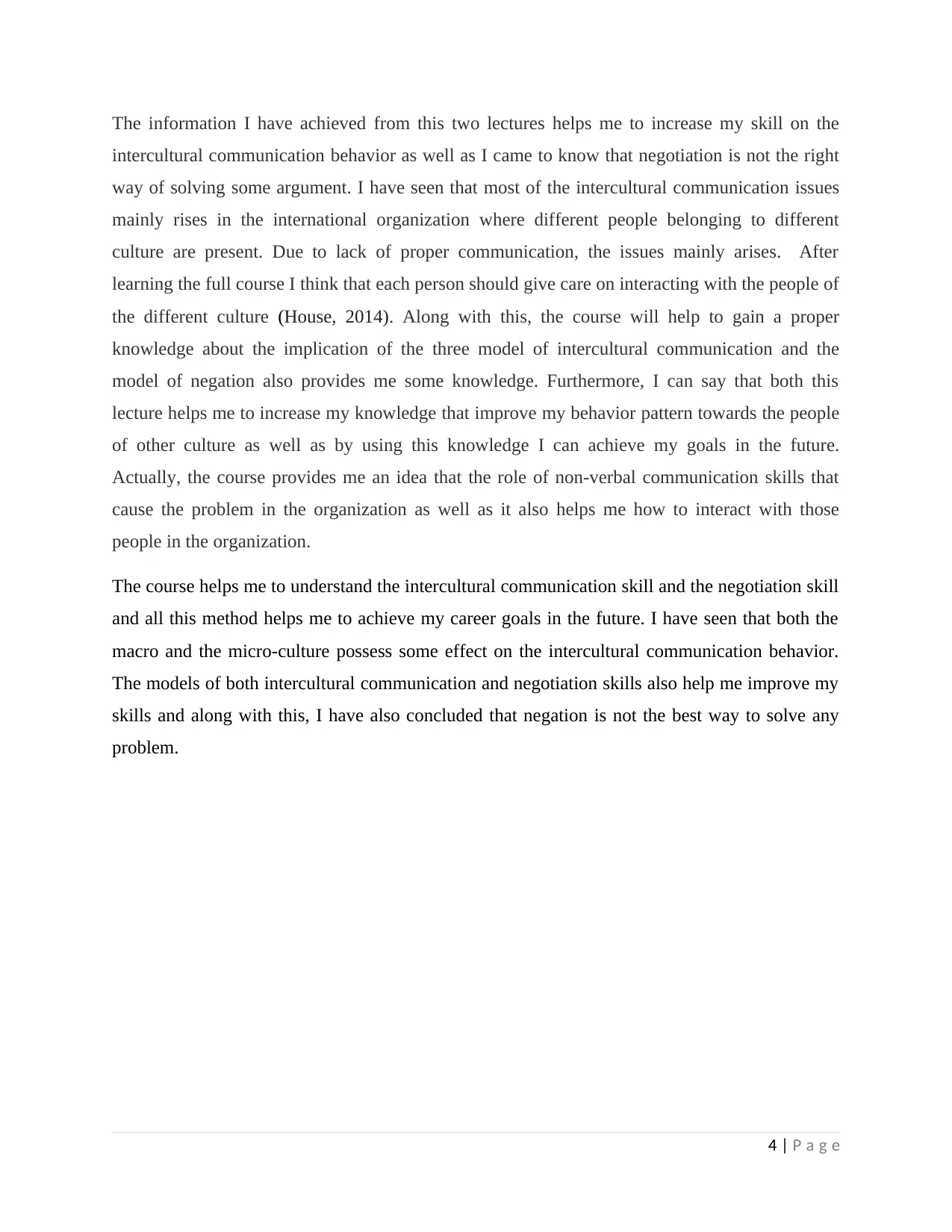
The information I have achieved from this two lectures helps me to increase my skill on the
intercultural communication behavior as well as I came to know that negotiation is not the right
way of solving some argument. I have seen that most of the intercultural communication issues
mainly rises in the international organization where different people belonging to different
culture are present. Due to lack of proper communication, the issues mainly arises. After
learning the full course I think that each person should give care on interacting with the people of
the different culture (House, 2014). Along with this, the course will help to gain a proper
knowledge about the implication of the three model of intercultural communication and the
model of negation also provides me some knowledge. Furthermore, I can say that both this
lecture helps me to increase my knowledge that improve my behavior pattern towards the people
of other culture as well as by using this knowledge I can achieve my goals in the future.
Actually, the course provides me an idea that the role of non-verbal communication skills that
cause the problem in the organization as well as it also helps me how to interact with those
people in the organization.
The course helps me to understand the intercultural communication skill and the negotiation skill
and all this method helps me to achieve my career goals in the future. I have seen that both the
macro and the micro-culture possess some effect on the intercultural communication behavior.
The models of both intercultural communication and negotiation skills also help me improve my
skills and along with this, I have also concluded that negation is not the best way to solve any
problem.
4 | P a g e
intercultural communication behavior as well as I came to know that negotiation is not the right
way of solving some argument. I have seen that most of the intercultural communication issues
mainly rises in the international organization where different people belonging to different
culture are present. Due to lack of proper communication, the issues mainly arises. After
learning the full course I think that each person should give care on interacting with the people of
the different culture (House, 2014). Along with this, the course will help to gain a proper
knowledge about the implication of the three model of intercultural communication and the
model of negation also provides me some knowledge. Furthermore, I can say that both this
lecture helps me to increase my knowledge that improve my behavior pattern towards the people
of other culture as well as by using this knowledge I can achieve my goals in the future.
Actually, the course provides me an idea that the role of non-verbal communication skills that
cause the problem in the organization as well as it also helps me how to interact with those
people in the organization.
The course helps me to understand the intercultural communication skill and the negotiation skill
and all this method helps me to achieve my career goals in the future. I have seen that both the
macro and the micro-culture possess some effect on the intercultural communication behavior.
The models of both intercultural communication and negotiation skills also help me improve my
skills and along with this, I have also concluded that negation is not the best way to solve any
problem.
4 | P a g e
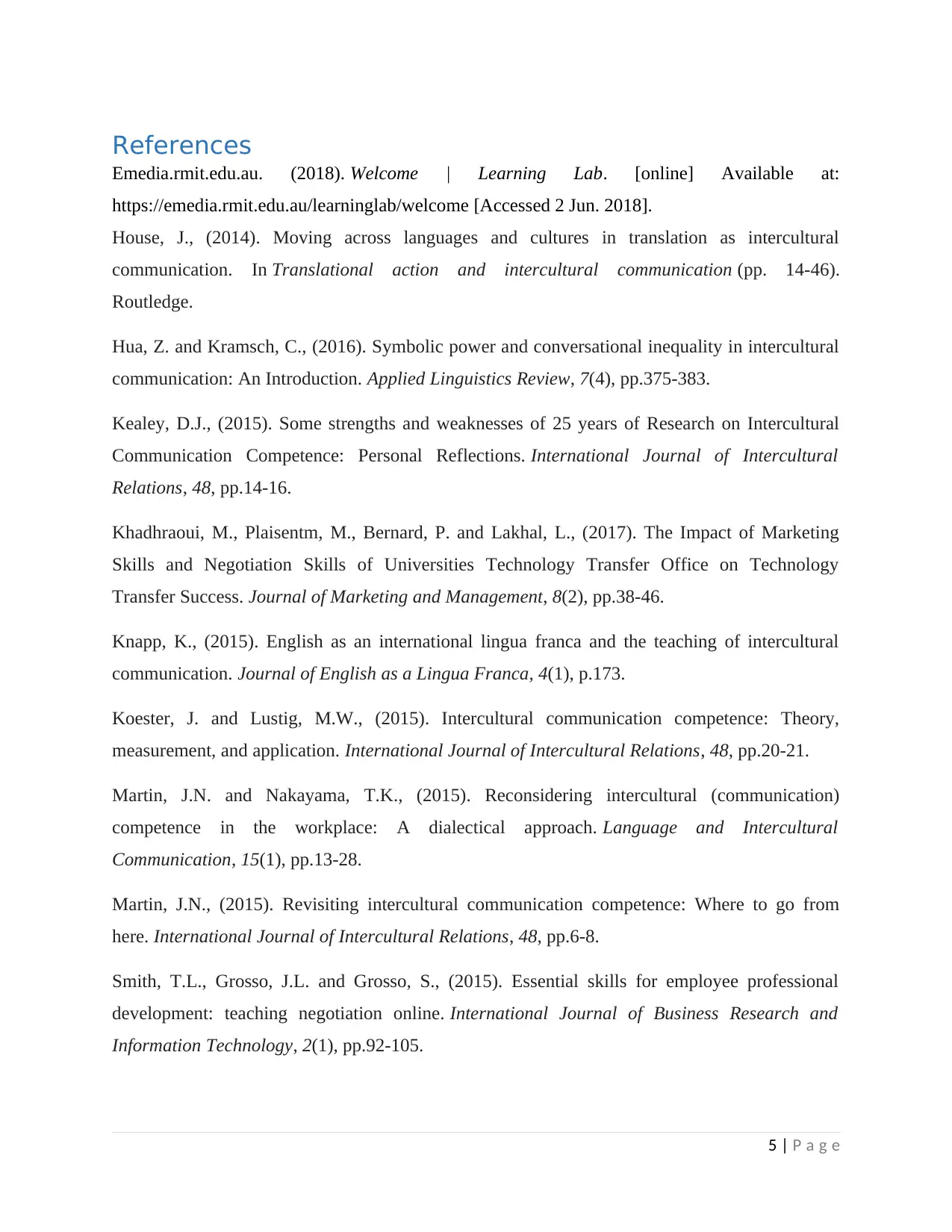
References
Emedia.rmit.edu.au. (2018). Welcome | Learning Lab. [online] Available at:
https://emedia.rmit.edu.au/learninglab/welcome [Accessed 2 Jun. 2018].
House, J., (2014). Moving across languages and cultures in translation as intercultural
communication. In Translational action and intercultural communication (pp. 14-46).
Routledge.
Hua, Z. and Kramsch, C., (2016). Symbolic power and conversational inequality in intercultural
communication: An Introduction. Applied Linguistics Review, 7(4), pp.375-383.
Kealey, D.J., (2015). Some strengths and weaknesses of 25 years of Research on Intercultural
Communication Competence: Personal Reflections. International Journal of Intercultural
Relations, 48, pp.14-16.
Khadhraoui, M., Plaisentm, M., Bernard, P. and Lakhal, L., (2017). The Impact of Marketing
Skills and Negotiation Skills of Universities Technology Transfer Office on Technology
Transfer Success. Journal of Marketing and Management, 8(2), pp.38-46.
Knapp, K., (2015). English as an international lingua franca and the teaching of intercultural
communication. Journal of English as a Lingua Franca, 4(1), p.173.
Koester, J. and Lustig, M.W., (2015). Intercultural communication competence: Theory,
measurement, and application. International Journal of Intercultural Relations, 48, pp.20-21.
Martin, J.N. and Nakayama, T.K., (2015). Reconsidering intercultural (communication)
competence in the workplace: A dialectical approach. Language and Intercultural
Communication, 15(1), pp.13-28.
Martin, J.N., (2015). Revisiting intercultural communication competence: Where to go from
here. International Journal of Intercultural Relations, 48, pp.6-8.
Smith, T.L., Grosso, J.L. and Grosso, S., (2015). Essential skills for employee professional
development: teaching negotiation online. International Journal of Business Research and
Information Technology, 2(1), pp.92-105.
5 | P a g e
Emedia.rmit.edu.au. (2018). Welcome | Learning Lab. [online] Available at:
https://emedia.rmit.edu.au/learninglab/welcome [Accessed 2 Jun. 2018].
House, J., (2014). Moving across languages and cultures in translation as intercultural
communication. In Translational action and intercultural communication (pp. 14-46).
Routledge.
Hua, Z. and Kramsch, C., (2016). Symbolic power and conversational inequality in intercultural
communication: An Introduction. Applied Linguistics Review, 7(4), pp.375-383.
Kealey, D.J., (2015). Some strengths and weaknesses of 25 years of Research on Intercultural
Communication Competence: Personal Reflections. International Journal of Intercultural
Relations, 48, pp.14-16.
Khadhraoui, M., Plaisentm, M., Bernard, P. and Lakhal, L., (2017). The Impact of Marketing
Skills and Negotiation Skills of Universities Technology Transfer Office on Technology
Transfer Success. Journal of Marketing and Management, 8(2), pp.38-46.
Knapp, K., (2015). English as an international lingua franca and the teaching of intercultural
communication. Journal of English as a Lingua Franca, 4(1), p.173.
Koester, J. and Lustig, M.W., (2015). Intercultural communication competence: Theory,
measurement, and application. International Journal of Intercultural Relations, 48, pp.20-21.
Martin, J.N. and Nakayama, T.K., (2015). Reconsidering intercultural (communication)
competence in the workplace: A dialectical approach. Language and Intercultural
Communication, 15(1), pp.13-28.
Martin, J.N., (2015). Revisiting intercultural communication competence: Where to go from
here. International Journal of Intercultural Relations, 48, pp.6-8.
Smith, T.L., Grosso, J.L. and Grosso, S., (2015). Essential skills for employee professional
development: teaching negotiation online. International Journal of Business Research and
Information Technology, 2(1), pp.92-105.
5 | P a g e
⊘ This is a preview!⊘
Do you want full access?
Subscribe today to unlock all pages.

Trusted by 1+ million students worldwide
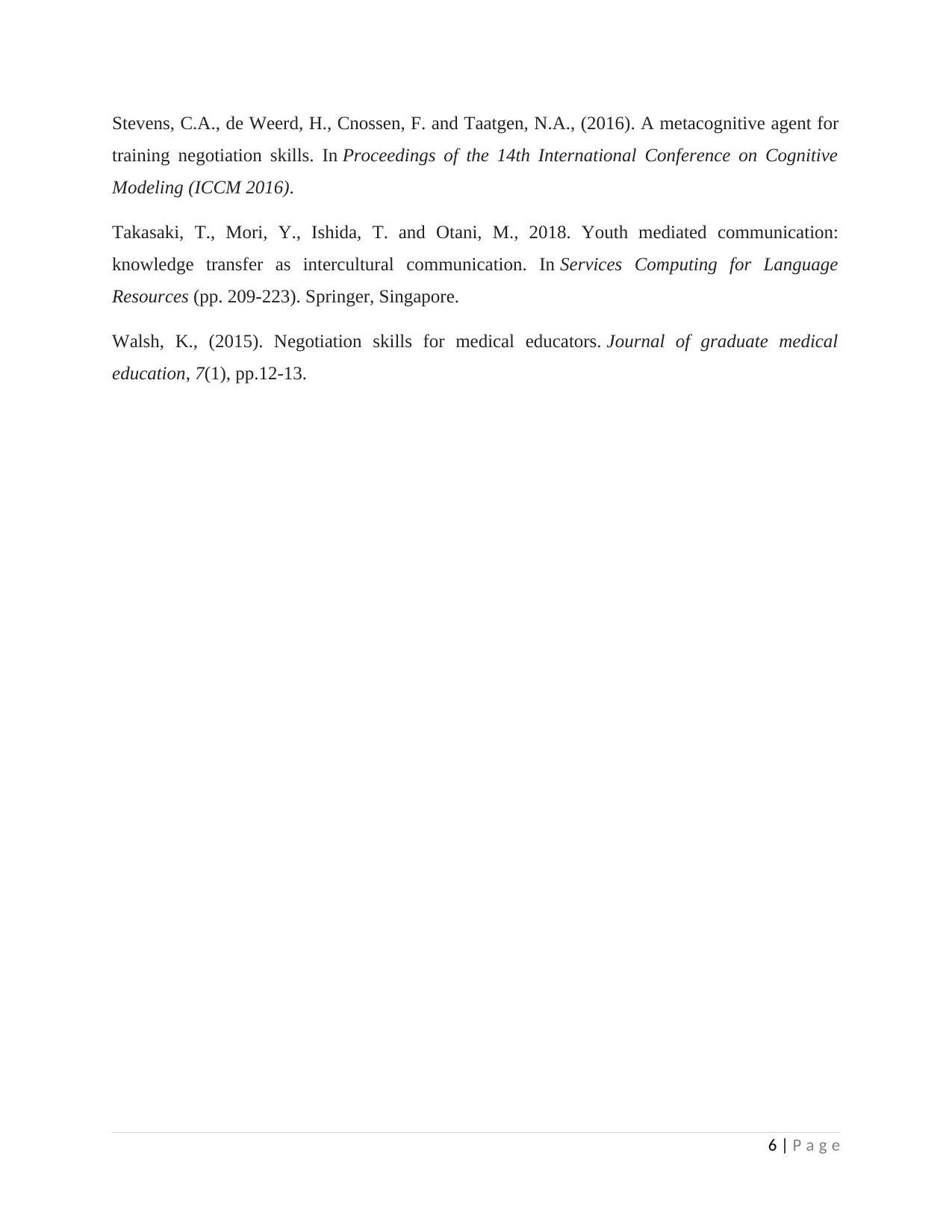
Stevens, C.A., de Weerd, H., Cnossen, F. and Taatgen, N.A., (2016). A metacognitive agent for
training negotiation skills. In Proceedings of the 14th International Conference on Cognitive
Modeling (ICCM 2016).
Takasaki, T., Mori, Y., Ishida, T. and Otani, M., 2018. Youth mediated communication:
knowledge transfer as intercultural communication. In Services Computing for Language
Resources (pp. 209-223). Springer, Singapore.
Walsh, K., (2015). Negotiation skills for medical educators. Journal of graduate medical
education, 7(1), pp.12-13.
6 | P a g e
training negotiation skills. In Proceedings of the 14th International Conference on Cognitive
Modeling (ICCM 2016).
Takasaki, T., Mori, Y., Ishida, T. and Otani, M., 2018. Youth mediated communication:
knowledge transfer as intercultural communication. In Services Computing for Language
Resources (pp. 209-223). Springer, Singapore.
Walsh, K., (2015). Negotiation skills for medical educators. Journal of graduate medical
education, 7(1), pp.12-13.
6 | P a g e
1 out of 7
Related Documents
Your All-in-One AI-Powered Toolkit for Academic Success.
+13062052269
info@desklib.com
Available 24*7 on WhatsApp / Email
![[object Object]](/_next/static/media/star-bottom.7253800d.svg)
Unlock your academic potential
Copyright © 2020–2025 A2Z Services. All Rights Reserved. Developed and managed by ZUCOL.





